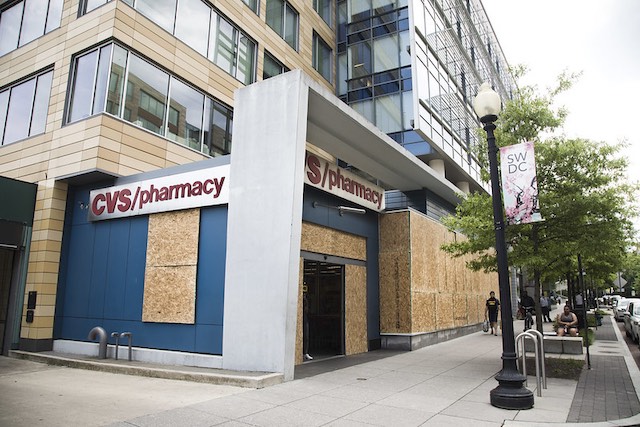Crime, on-line shopping, telecommuting and exorbitant rents are all contributing to the decline of downtowns, observes an article on CNN Business. But the real reason downtowns are declining, according to the article, is that people don’t live in dense enough neighborhoods.
If we just had more density, this wouldn’t be a problem, say the densimaniacs — except this boarded up pharmacy is in one of the densest neighborhoods in the country. Photo by thisisbossi.
“To reinvent downtown retail,” asserts the article without any room for debate or citation of evidence, cities need “denser neighborhoods with a broader mix of affordable housing, experiential retail, restaurants, entertainment, parks and other amenities.” Where have I heard that before?
How are denser neighborhoods going to solve crime and homeless problems? How are they going to fill office spaces when people are working at home? How will they get people to stop shopping on line? How will they make rents more affordable when higher densitis increase land values?
“Downtowns are for people,” the article goes on to say, so downtown streets should be closed to cars, which the writer apparently believes never have any people in them. And of course, if we closed the streets, they wouldn’t immediately be filled with tents for homeless people, would they?
Downtowns were created for people, not the other way around. Why should Americans be forced to change their lifestyles to benefit downtowns if downtowns no longer benefit Americans as much as they once did?
What is wrong with urban planners that, no matter what the problem, they always trot out the same tired old prescriptions: density and anti-auto policies? What is wrong with CNN Business that it presents this wrong-headed opinion piece as news without any question?









I’ll stick alone with crime and exorbitant rents….People don’t realize that outside Asia the skyscraper is obsolete, they’re not built to accommodate the boom and bust cycles of real estate. This is best summed up in places like Dubai and China where highrise construction has broke record pace, but many of them are virtually empty.
phenomena I’ve observed is the abandonment effect where companies that often chose new highrises to headquarter or consolidate often leave in a few years for cheaper offices else where.
Singer Building (Singer sewing machine company) left for new offices
Sears Roebuck: occupied the Sears tower in 1974, left in 1991 for a cheaper low rise office campus in the suburbs.
Chrysler Building: Chrysler sold the holding in 1953
PanAm building, later MetLife building, sold in 2005, but the name remains.
China built 2nd (now 3rd) tallest building in the world. Shanghai Tower. At 2073 feet and 128 stories, the organic shaped building is a nightmare. Because it’s rounded tapered floor plan makes 30% floor space unusable, the building sits mostly empty. 2020, major water leaks broke out from the 60th to the 9th floor of the tower, which damaged a large quantity of office equipment and electronics.
Here’s an idea … the federal government (the only source of funds for such ideas) can convert all the empty and soon to be empty department stores and office buildings into apartments and condominiums.
They can start with San Francisco.
Downtowns are for people is the newest fad.
It’ll be interesting to see what, if any, residential development happens downtown. There may be a lot of people who aren’t wanting to nor capable of paying downtown prices unless they work downtown.
Governments will just subsidize downtown apartment complexes.
I’m not sure what’s going on in Atlanta, but it appears that they are building offices and apartments/condos like crazy. From the dystopia it was 40 years ago, it has become quite the playground for those who can afford it.